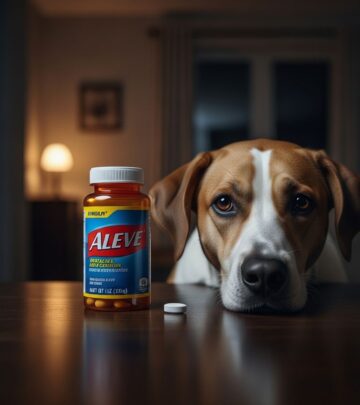Cushing’s Disease In Dogs: 9 Key Signs & Treatment
Understanding this common endocrine disorder that affects many senior dogs and how to manage it effectively

Image: HearthJunction Design Team
What is Cushing’s Disease in Dogs?
Cushing’s disease, also known as hyperadrenocorticism, is a common endocrine disorder that primarily affects middle-aged and older dogs. This condition occurs when the body produces excessive amounts of cortisol, a stress hormone that plays crucial roles in many bodily functions. While cortisol is essential for life in appropriate amounts, too much of this hormone can lead to serious health problems for your canine companion.
Cortisol helps regulate metabolism, blood sugar levels, and immune responses. It also assists dogs in responding to stress. However, when cortisol levels remain chronically elevated, as occurs in Cushing’s disease, it can disrupt normal bodily functions and lead to a variety of concerning symptoms that affect your dog’s quality of life.
Types of Cushing’s Disease in Dogs
There are three main types of Cushing’s disease that can affect dogs, each with a different underlying cause:
Pituitary-Dependent Cushing’s Disease
Approximately 80-85% of Cushing’s disease cases in dogs are pituitary-dependent. This form is caused by a tumor (usually benign) on the pituitary gland, a small gland located at the base of the brain. The pituitary tumor triggers the overproduction of adrenocorticotropic hormone (ACTH), which signals the adrenal glands to produce excessive amounts of cortisol.
Adrenal-Dependent Cushing’s Disease
About 15-20% of canine Cushing’s cases are adrenal-dependent, resulting from a tumor on one or both adrenal glands. These tumors directly produce excess cortisol, bypassing the normal regulatory mechanisms. Adrenal tumors can be either benign or malignant, with malignant tumors potentially spreading to other parts of the body.
Iatrogenic Cushing’s Syndrome
This type occurs when dogs receive long-term or high doses of corticosteroid medications for conditions like allergies, immune disorders, or inflammation. The extended use of these medications can mimic natural Cushing’s disease by creating artificially elevated cortisol levels in the body.
Common Symptoms of Cushing’s Disease in Dogs
Cushing’s disease typically develops gradually, and symptoms may initially be mild or attributed to normal aging. As the disease progresses, symptoms become more noticeable and can significantly impact your dog’s quality of life. The most common signs include:
- Increased thirst and urination: Dogs with Cushing’s disease often drink excessive amounts of water and consequently urinate more frequently. House-trained dogs may begin having accidents indoors due to their inability to hold their urine.
- Increased appetite: Affected dogs may show an insatiable hunger, sometimes stealing food or begging more persistently than before.
- Potbelly appearance: A characteristic distended or pot-bellied abdomen develops as muscles weaken and fat redistributes.
- Muscle weakness: Dogs may show reduced activity levels, reluctance to exercise, or difficulty climbing stairs or jumping.
- Hair loss: Symmetrical hair loss often occurs, typically starting on the body while sparing the head and legs.
- Skin problems: The skin may become thin, easily bruised, and slow to heal. Some dogs develop dark pigmentation or calcium deposits in the skin.
- Panting: Excessive or persistent panting, even when at rest or in cool environments.
- Lethargy: General tiredness or lack of energy is common.
- Recurrent infections: Particularly urinary tract infections and skin infections due to compromised immune function.
It’s important to note that not all dogs will show all symptoms, and the severity can vary widely between individuals. Additionally, these symptoms can also indicate other health conditions, making proper veterinary diagnosis essential.
Risk Factors for Developing Cushing’s Disease
While Cushing’s disease can affect any dog, certain factors may increase the risk:
Age
Cushing’s disease most commonly affects middle-aged to older dogs, with the average age of diagnosis being about 10-11 years. However, it can occasionally develop in younger dogs as well.
Breed Predisposition
Some dog breeds appear to have a higher predisposition to developing Cushing’s disease, including:
- Poodles (particularly miniature poodles)
- Dachshunds
- Boston Terriers
- Boxers
- Beagles
- German Shepherds
- Yorkshire Terriers
Size
Small to medium-sized breeds are diagnosed with Cushing’s disease more frequently than larger breeds, although the condition can affect dogs of any size.
How Veterinarians Diagnose Cushing’s Disease in Dogs
Diagnosing Cushing’s disease can be challenging as its symptoms often overlap with other conditions and the normal aging process. Additionally, no single test is 100% accurate for diagnosing this condition. Your veterinarian will typically use a combination of approaches:
Initial Evaluation
Your veterinarian will start with a thorough physical examination and detailed discussion of your dog’s symptoms, medical history, and any medications they’re currently taking. This initial assessment helps determine if Cushing’s disease is a likely explanation for your dog’s symptoms.
Basic Laboratory Tests
Before performing specific hormone tests, your veterinarian will likely recommend:
- Complete blood count (CBC): To examine blood cells and check for changes characteristic of Cushing’s disease, such as an increase in neutrophils and a decrease in lymphocytes and eosinophils.
- Blood chemistry panel: To assess organ function and look for elevated liver enzymes (particularly alkaline phosphatase), high cholesterol, and increased blood glucose, which are common in dogs with Cushing’s.
- Urinalysis: To check for dilute urine and possible urinary tract infections, which frequently occur in dogs with Cushing’s disease.
Specialized Hormone Testing
If the initial test results suggest Cushing’s disease, your veterinarian will recommend one or more of the following specialized tests:
Low-Dose Dexamethasone Suppression Test (LDDST)
This is often considered the most reliable screening test for Cushing’s disease. The process involves:
- Taking a baseline blood sample to measure resting cortisol levels
- Administering a low dose of dexamethasone (a synthetic cortisol) by injection
- Collecting additional blood samples at 4 and 8 hours after injection
In healthy dogs, dexamethasone suppresses the body’s natural cortisol production. In dogs with Cushing’s disease, cortisol levels remain elevated even after dexamethasone administration.
ACTH Stimulation Test
This test evaluates how well the adrenal glands respond to adrenocorticotropic hormone (ACTH). The procedure includes:
- Taking a baseline blood sample to measure resting cortisol levels
- Administering synthetic ACTH by injection
- Collecting a second blood sample 1-2 hours later
Dogs with Cushing’s disease typically show an exaggerated cortisol response to the ACTH stimulation.
High-Dose Dexamethasone Suppression Test
Similar to the LDDST but using a higher dose of dexamethasone, this test helps differentiate between pituitary-dependent and adrenal-dependent Cushing’s disease. Dogs with pituitary-dependent Cushing’s typically show some suppression of cortisol after receiving a high dose of dexamethasone, while those with adrenal tumors usually show no suppression.
Urine Cortisol:Creatinine Ratio
This test measures the amount of cortisol excreted in the urine compared to creatinine. While it can be useful as an initial screening tool, it has a high rate of false positives and must be followed by more specific tests.
Advanced Imaging
Once Cushing’s disease is diagnosed, your veterinarian may recommend imaging studies to determine the cause and guide treatment decisions:
- Abdominal ultrasound: To visualize the adrenal glands and check for tumors or enlargement. This can help distinguish between pituitary-dependent and adrenal-dependent Cushing’s.
- CT scan or MRI: These advanced imaging techniques may be recommended to evaluate the pituitary gland for tumors, particularly if surgical intervention is being considered.
- Chest X-rays: Sometimes performed to check for potential spread of malignant adrenal tumors to the lungs.
Treatment Options for Cushing’s Disease
Treatment approaches for Cushing’s disease depend on the type and underlying cause. The goal is to reduce cortisol production and manage symptoms to improve your dog’s quality of life.
Medication Management
For most dogs with pituitary-dependent Cushing’s disease, medication is the primary treatment approach:
Trilostane (Vetoryl)
This is the only FDA-approved medication for both pituitary-dependent and adrenal-dependent Cushing’s disease in dogs. Trilostane works by blocking the production of cortisol in the adrenal glands. Regular monitoring with ACTH stimulation tests is essential to ensure proper dosing.
Mitotane (Lysodren)
Though not FDA-approved specifically for canine Cushing’s disease, mitotane is sometimes used as an alternative. It works by selectively destroying the cortisol-producing cells in the adrenal glands. Close monitoring is critical as overdosing can cause Addison’s disease (cortisol deficiency).
Surgical Options
For some dogs, surgical intervention may be appropriate:
- Adrenalectomy: Surgical removal of an adrenal tumor is the treatment of choice for adrenal-dependent Cushing’s disease, particularly when the tumor is unilateral and has not spread.
- Hypophysectomy (pituitary surgery): This complex surgery to remove a pituitary tumor is only available at specialized veterinary centers and is relatively rare in veterinary medicine.
Treatment for Iatrogenic Cushing’s Syndrome
For dogs with iatrogenic Cushing’s syndrome, treatment involves gradually reducing and potentially eliminating the corticosteroid medication causing the condition. This must be done carefully and under veterinary supervision, as abrupt discontinuation can be dangerous.
Living with and Managing Cushing’s Disease
While Cushing’s disease cannot be cured in most cases, it can be successfully managed to provide your dog with a good quality of life. Management typically involves:
Regular Veterinary Monitoring
Dogs with Cushing’s disease require frequent check-ups and blood tests, especially during the initial stages of treatment, to ensure that medication dosages are appropriate and to monitor for potential side effects.
Lifestyle Adjustments
Some lifestyle changes that may help dogs with Cushing’s disease include:
- Ensuring constant access to fresh water to accommodate increased thirst
- Providing more frequent opportunities to urinate to prevent accidents
- Maintaining a consistent, balanced diet that supports overall health
- Engaging in regular, gentle exercise appropriate for your dog’s condition
- Taking steps to prevent skin infections by keeping your dog clean and dry
Monitoring for Complications
Dogs with Cushing’s disease are at increased risk for certain complications, including:
- High blood pressure
- Diabetes mellitus
- Blood clots
- Urinary tract infections
- Pancreatitis
Regular monitoring for these conditions allows for early intervention if they develop.
Prognosis and Life Expectancy
With proper treatment and management, many dogs with Cushing’s disease can live comfortably for years after diagnosis. The prognosis varies depending on several factors:
- The type of Cushing’s disease (pituitary-dependent typically has a better prognosis than adrenal-dependent caused by malignant tumors)
- The age and overall health of the dog at diagnosis
- How well the condition responds to treatment
- The development of complications
On average, dogs with well-managed pituitary-dependent Cushing’s disease have a survival time of about 2-3 years after diagnosis, though many live longer with a good quality of life.
When to Contact Your Veterinarian
If your dog is being treated for Cushing’s disease, contact your veterinarian promptly if you notice:
- Decreased appetite or refusal to eat
- Vomiting or diarrhea
- Lethargy or weakness
- Collapse or difficulty standing
- Restlessness or disorientation
These could indicate medication side effects or complications that require immediate attention.
Frequently Asked Questions (FAQs)
Q: Can Cushing’s disease in dogs be prevented?
A: Unfortunately, there are no known prevention methods for naturally occurring Cushing’s disease. Iatrogenic Cushing’s syndrome can be prevented by using the lowest effective dose of corticosteroid medications for the shortest time necessary.
Q: Is Cushing’s disease painful for dogs?
A: Cushing’s disease itself is not typically painful, but some of its complications, such as urinary tract infections or skin infections, may cause discomfort. The muscle weakness and other symptoms can also reduce quality of life if left untreated.
Q: Will my dog’s appearance return to normal after treatment begins?
A: Many physical changes associated with Cushing’s disease improve with successful treatment. The pot-bellied appearance often diminishes, and hair may regrow, though some changes may be permanent, especially if the condition was present for a long time before diagnosis.
Q: Do all dogs with Cushing’s disease require lifelong medication?
A: Most dogs with naturally occurring Cushing’s disease will need lifelong medication. The exception is dogs with adrenal tumors that are successfully removed surgically and dogs with iatrogenic Cushing’s syndrome, who may recover when the causative medication is properly discontinued.
Q: How expensive is treatment for Cushing’s disease?
A: Treatment for Cushing’s disease can be costly, including initial diagnostic tests, medication, and regular monitoring. The exact cost varies depending on your location, the specific treatment protocol, and whether complications develop. Pet insurance may help cover some of these expenses if the policy was in place before diagnosis.
References
- https://www.fda.gov/consumers/consumer-updates/treating-cushings-disease-dogs
- https://www.petmd.com/dog/conditions/endocrine/cushings-disease-in-dogs-symptoms-diagnosis
- https://vcahospitals.com/know-your-pet/cushings-disease-in-dogs
- https://www.vet.cornell.edu/departments-centers-and-institutes/riney-canine-health-center/canine-health-information/cushings-syndrome
- https://www.webmd.com/pets/dogs/cushings-syndrome-dogs
Read full bio of Anjali Sayee












